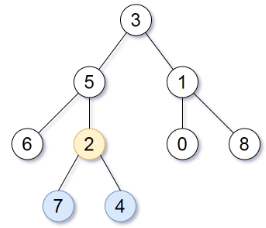版权声明:本文为博主原创文章,博客地址:https://blog.csdn.net/qq_41855420,未经博主允许不得转载。 https://blog.csdn.net/qq_41855420/article/details/91346979
给定一个根为 root 的二叉树,每个结点的深度是它到根的最短距离。
如果一个结点在整个树的任意结点之间具有最大的深度,则该结点是最深的。
一个结点的子树是该结点加上它的所有后代的集合。
返回能满足“以该结点为根的子树中包含所有最深的结点”这一条件的具有最大深度的结点。
示例:
输入:[3,5,1,6,2,0,8,null,null,7,4]
输出:[2,7,4]
解释:

我们返回值为 2 的结点,在图中用黄色标记。
在图中用蓝色标记的是树的最深的结点。
输入 "[3, 5, 1, 6, 2, 0, 8, null, null, 7, 4]" 是对给定的树的序列化表述。
输出 "[2, 7, 4]" 是对根结点的值为 2 的子树的序列化表述。
输入和输出都具有 TreeNode 类型。
提示:
树中结点的数量介于 1 和 500 之间。
每个结点的值都是独一无二的。
对于求一棵树的最大深度,只需要利用递归算法即可,
depth(root) = 1 + max(depth(root->left), depth(root->right));
如果depth(root->left) == depth(root->right),则root必定是结果节点(因为需要同时需要包含left、right子树)
如果depth(root->left) > depth(root->right),则深度最大的子树在root->left
否则深度最大的子树在root->right。
/**
* Definition for a binary tree node.
* struct TreeNode {
* int val;
* TreeNode *left;
* TreeNode *right;
* TreeNode(int x) : val(x), left(NULL), right(NULL) {}
* };
*/
class Solution {
public:
TreeNode* subtreeWithAllDeepest(TreeNode* root) {
if(root == NULL) {
return root;
}
int leftDeep = depth(root->left), rightDeep = depth(root->right);
if(leftDeep == rightDeep) {
//root必定是结果节点(因为需要同时需要包含left、right子树)
return root;
}
else if(leftDeep > rightDeep) {
//深度最大的子树在root->left
return subtreeWithAllDeepest(root->left);
}
else{
//否则深度最大的子树在root->right。
return subtreeWithAllDeepest(root->right);
}
}
//获取以root为根的子树的最大升读
int depth(TreeNode *root){
if(root == NULL) {
return 0;
}
return 1 + max(depth(root->left), depth(root->right));
}
};
